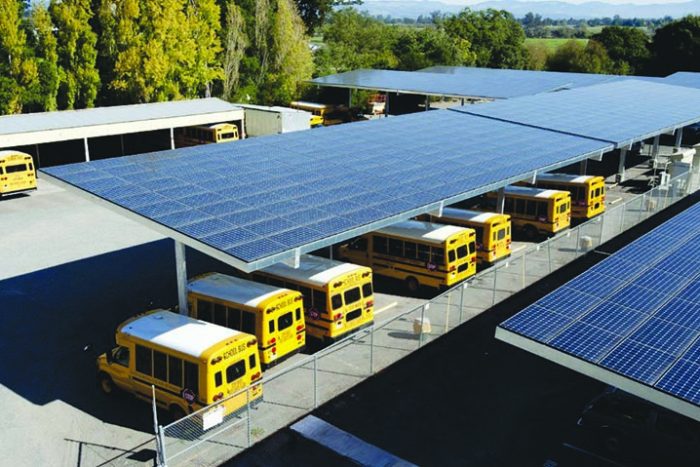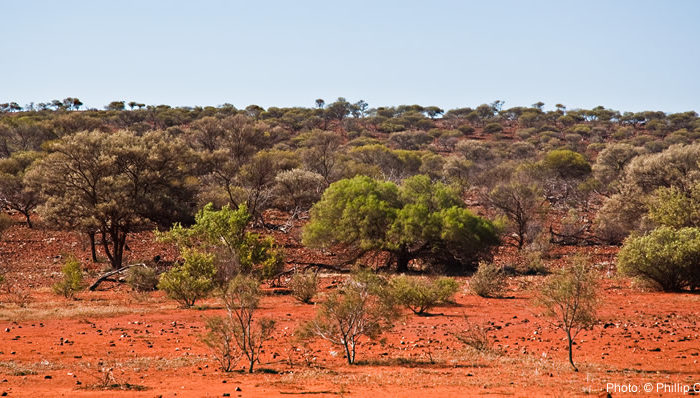EarthSpark International, a nonprofit focused on bringing energy access to Haiti’s rural poor, has just received $10 million dollars from the UN Green Climate Fund. EarthSpark will use the money to continue and expand its efforts to build high-quality microgrids that deliver renewable electricity to over 20 towns without any access to power. Renewable electricity will help consumers save more than 50 percent of what they currently spend on kerosene, charcoal and diesel fuel:
Top Stories
Mountain microgrid: Alternative Power Enterprises designs an off-grid ranch system with HOMER Pro
One of the biggest microgrids on Colorado’s Western Slope powers a remote vacation ranch. Alternative Power Enterprises designed and built the project. Learn about how the design decisions that were made are saving money and increasing resiliency:
Earth Day 2020: Celebrating the 50th Anniversary
Today is the 50th Anniversary of Earth Day, when millions of Americans protested air and water pollution, pesticides and waste. That event prompted important actions that improved air and water quality. Now Earth Day is worldwide, and together we face the challenge of global warming. Renewable energy is progressing rapidly. Can we harness this technology to help mitigate climate change?
Elizabeth May Looks to Canada’s Green Future
Attorney, activist and member of the Canadian Parliament Elizabeth May led Canada’s Green Party for 13 years, stepping down in late 2019. We wanted to catch up with her and hear about her upcoming environmental priorities:
Powering Patagonia Parks with Low Head Hydro Microgrids
In the wildest reaches of Patagonia, distributed energy experts are building microgrids that exploit the abundant low head hydro resources in the region. These systems are providing energy for amenities in some of the most magnificent new parks in the world:
Santa Barbara Schools Look to Microgrids for Community Resilience and EV Charging
Plans are underway to build a microgrid for every one of 21 schools in the Santa Barbara Unified School District. Since the city is vulnerable to power outages from forest fires, earthquakes, heavy rains and mudslides, local officials want a more resilient power system. The Clean Coalition is leading the microgrid effort:
Darwin’s Finches: The race to decarbonize an ecological treasure
The Galápagos Islands are among the world’s most unique and climate-vulnerable ecosystems. Now engineers from the Instituto de Energía Solar of the Universidad Politécnica de Madrid (IES-UPM) are using HOMER Pro to improve the local energy systems. They will be increasing renewable resources and reducing the use of diesel fuel through optimization of a key island microgrid:
Collaboration sparks innovation: Three landmark projects explore the future of power provision
Three southern communities are now developing “smart neighborhood” microgrids. In one, energy-efficient homes feature community-scale microgrids designed by Alabama Power / Southern Company and modeled by HOMER Grid. The project should yield new information about how to design and integrate distributed renewable energy into our electricity grid;
When Microgrids Mean Hope: Powering a Refugee Settlement in Shimelba, Ethiopia
A microgrid, modeled and designed with HOMER Pro, is bringing power to a refugee camp in Ethiopia. Most of the 6,000 refugees in the Shimelba camp come from Eritrea, where they have fled multiple crimes against humanity. Living in a refugee camp is an enormous hardship, but now the microgrid is supporting improved commerce, construction, agriculture, and most importantly, hope:
Maui Brewing Company Uses HOMER Pro to Achieve Grid Independence and Work Towards 100% Renewable Status
Maui Brewing Company, Hawaii’s largest craft brewery, is achieving grid independence and working towards 100% renewable operation with a new microgrid that was modeled using HOMER Pro. Featuring a massive PV array (close to a MW), Tesla batteries and Cummins generators that run on biodiesel, the microgrid should save $300,000 per year, cutting the company’s energy costs in half:
Empowering Africa
Approximately one billion people around the world lack access to electricity, according to the World Bank, and more than half of those one billion people live in Africa. This has serious implications for global health, education, food security, gender equality, and global economies. We spoke with John Kidenda, the Director of Software, Analytics and Customer Support at PowerGen Renewable Energy, where he works to provide communities across Africa with sustainable, decentralized power in the form of mini-grids. John was a speaker at the HOMER International Microgrid Conference:
Kibera microgrid helps bring education, clean laundry and employment to Nairobi’s urban poor
In the middle of the Kibera, a large shantytown outside of Nairobi, a mirorgrid is powering a a new community center that provides clean water, showers, laundry facilities, internet service and classrooms for people who live in the surrounding neighborhood. It is also providing newfound hope and job training for the residents, according to Serena Patel, an Energy engineering student at the University of California at Berkeley is working on the microgrid. Serena will be presenting her findings at the HOMER International Microgrid Conference October 7-9 in Cambridge, MA. Learn more:
Bolivia Embarks on Microgrid Strategy as Part of Universal Energy Access Goal
The Bolivian government has launched an ambitious plan to diversify its national energy portfolio and improve energy access for populations living in rural areas. That plan involves investments in renewable energy and microgrids, for which HOMER Energy is providing training:
Container Microgrids: Lowering Costs Through Modular Design and Streamlined Engineering
In the ongoing effort to lower the cost of microgrid deployment, one concept that continues to evolve is that of the modular microgrid, best expressed in a system that can fit inside a single shipping container. It’s not a new idea. What is relatively new is a complete, stand-alone hybrid renewable energy system, such as the ones designed by BoxPower and Arizona State University:
California Utilities Plan Shutoffs to Forestall 2019 Fire Disasters
Reeling from several years of catastrophic wildfires and the financial losses that are looming in their wake, California utilities have a new strategy for dealing with fire risk: shutting off the electricity. The plan targets populations in high-risk fire zones – which include much of the state – and creates worrisome risk for vulnerable populations. MIcrogrids would improve resilience and soften the blow of power cuts.
Learning from Western Australia: A geography made for microgrids
With its massive land area, thinly scattered population and resource-based economy, Western Australia has always been challenged to maintain an electric grid that covers long distances under harsh environmental conditions. Utilities are discovering that hybrid renewable microgrids can be cheaper than the upkeep on such a sprawling electrical empire, and the state’s government is listening:
Locating Pittsburgh Microgrids for Climate Resilience and Calculating their Value
A University of Pittsburgh economist who specializes in analyzing the financial risk of climate impacts is working on calculating the value of microgrids to help provide greater resilience in cities. She’s using spacial techniques to determine where microgrids should be located to provide maximum service, and she’s using HOMER Pro calculate a cost-benefit analysis:
India’s Microgrid Market: Ready for Takeoff
India is a leader in renewable energy among developing countries and recently completed the world’s largest solar park. But beyond utility-scale installations, India is also working on a plan to build 10,000 microgrids to deliver energy access to the millions of people who still don’t have it. It’s no surprise that – of over 190 countries – India is also HOMER Energy’s second largest user base:
Improving Energy Access in Rural Africa Depends on Renewable Energy Microgrids
African countries are making rapid progress in adopting renewable energy and in fact, it is developing countries that are now leading the global transition to clean energy. However, energy access in Africa is still a huge problem for two thirds of the population, mostly for people who live in rural areas. The good news is that renewable energy microgrids are the fastest, most cost-effective path to electrification. That’s why several African countries have ambitious plans to expand microgrid investment
Using HOMER Grid to Calculate Financial Incentives for Storage and Peak Demand Reduction
Understanding the financial benefits of solar+storage for commercial utility customers is a complex task, especially when calculating incentives that vary widely from state to state. In this story we present a New England case where HOMER Grid was used to solve this complex problem:
Business Models Key to Successful Microgrids in Nepal
Currently, only 11% of Nepal’s rural population of about 23 million people has access to electricity. And many people who live in remote villages still subsist on kerosene and batteries. But, pioneering Nepalese renewable energy developer has spent almost a decade tackling the electricity challenge in Nepal. They have an impressive track record and some key lessons to pass along.
Using Games to Engage Communities in Microgrid Development
Energy Action Partners is harnessing the universal allure of games to engage developing country communities in the process of planning and designing sustainable energy projects. Minigrids (microgrids) that […]
Inside the World’s Most Advanced Microgrid: The University of California San Diego
One of the highlights of the HOMER International Microgrid Conference, held October 8-10 in San Diego was a tour of the microgrid at the University of California San […]
Pioneering Kaiser Microgrid Meets Stringent Safety and Reliability Standards and Saves Money Too
When Hospital Power Fails It’s hard to imagine a more mission-critical power user than a hospital. Hospital buildings require 24/7 heating, and cooling, and air-handling to maintain the […]
Caribbean Nations Explore New Business Models to Support Commercial Solar Development
It’s October, and that means it’s still hurricane season in the Caribbean. The people of the region and their governments can be forgiven for viewing each tropical depression […]
New Markets for Behind-the-Meter Wind? Now HOMER Grid Can Help Users Decide
The economics of distributed wind projects, ones that use small and medium-size turbines, could be looking promising as interest builds in the development of hybrid distributed energy development. […]
“Steel City:” Using HOMER Pro to Help Create a Resilient Energy Future for Pittsburgh
Microgrid technology is set to play a big role in the continued revitalization of the rust-belt city of Pittsburgh, according to Dr. Gregory Reed, professor of engineering at […]
Hybrid Microgrids Bring Solar to Niger
One of Africa’s poorest countries is embarking on a major project that will use solar to reduce the costs and pollution burden of diesel-powered village microgrids. The project […]
HOMER Pro: Helping to Build the World’s Largest Radio Telescope
HOMER Pro, the microgrid optimization platform, has been playing an important role in deploying one of the most ambitious science projects ever conceived: The Square Kilometer Array (SKA). […]
Pioneering Remote Microgrids in Alaska
With its extreme weather conditions and isolated off-grid communities, Alaska is the American microgrid “frontier.” Over 200 remotely powered Alaskan villages are not connected to power grids. They […]






























